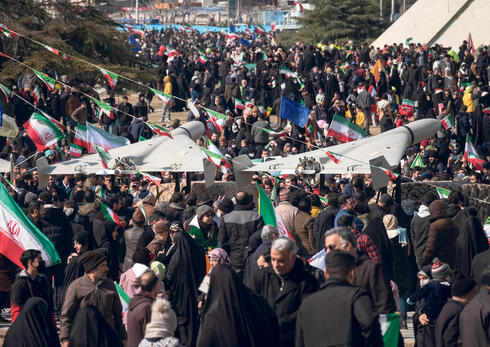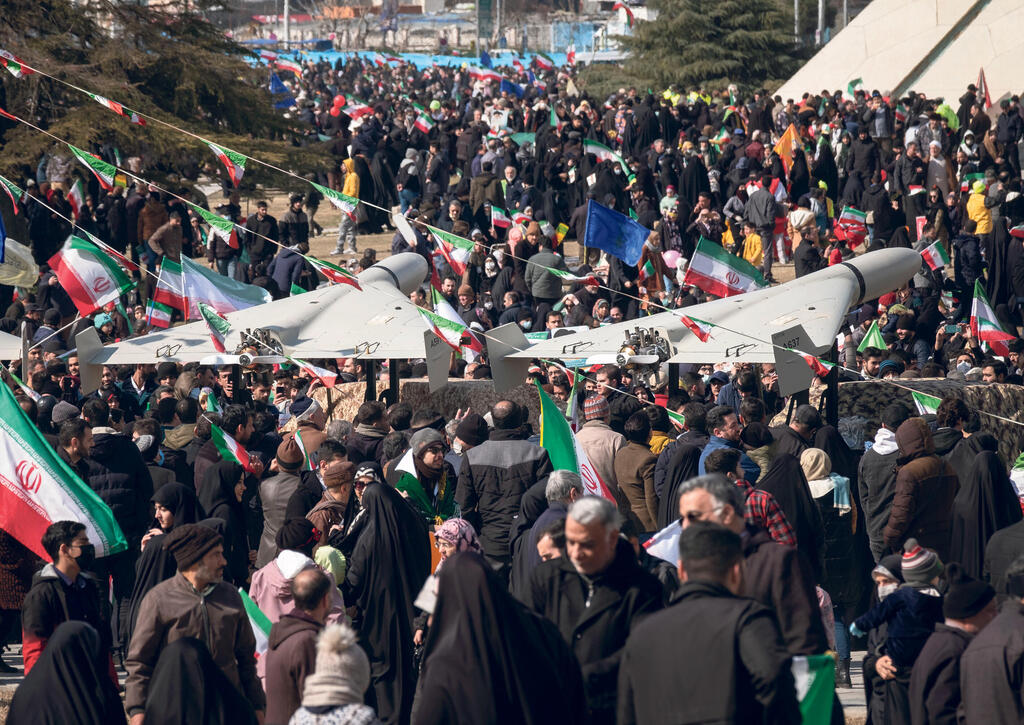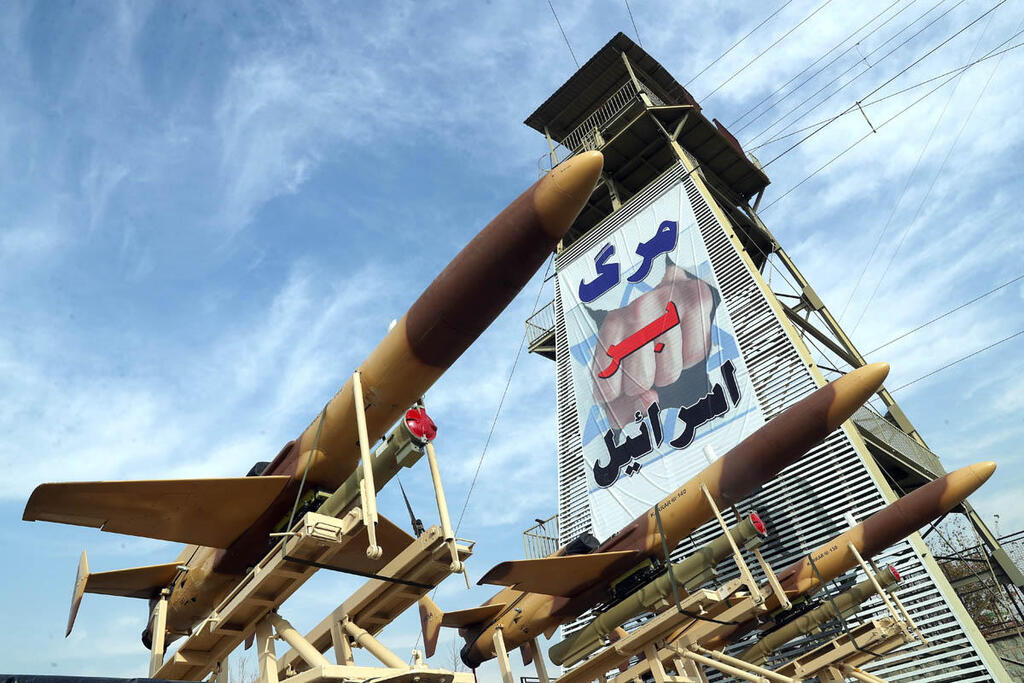
Israel investing hundreds of millions to counter Iran's kamikaze drones threat
The Israeli defense establishment has initiated a large-scale emergency procurement of defense systems to counter the challenge of intercepting massive swarms of unmanned aerial vehicles that could attack Israel should an all-out war break out with Hezbollah
The Israeli defense establishment has initiated a large-scale emergency procurement of defense systems to address one of the most worrisome scenarios that could unfold during an all-out war with Hezbollah: massive swarms of unmanned aerial vehicles (UAVs), commonly known as "suicide drones." These drones are intended to target power plants, air force bases, concentrations of forces, and critical infrastructure, all vital for maintaining the functional continuity of the economy during an emergency.
The threat posed by suicide drones is considered significant and tangible, even though Israel boasts the most advanced and sophisticated multi-layered air defense system in the world. However, the defense missiles that form the basis of the system are not designed to handle dozens of drones, which fly at a relatively slow speed and low altitude, while being directed at a predefined target.
An illustration of this complex challenge emerged earlier this week when a suicide drone attacked the Tower 22 post in northeastern Jordan, resulting in the death of three American soldiers and the injury of 40 others. Estimates suggest that the drone was launched by a pro-Iranian militia. A similar incident occurred a few weeks ago north of Safed, where a suicide drone targeted an Israeli air force command base in a retaliatory action by Hezbollah following the assassination of a senior Hamas official, Saleh al-Arouri, in Beirut. Additionally, a reservist was killed by a Hezbollah-launched suicide drone near the village of Margaliot on the northern border a few weeks prior.
Since the commencement of the war in Gaza and the concerns about its expansion into Lebanon against Hezbollah, the defense establishment has been in a race to equip itself with electronic warfare (EW) systems. This effort aims to enhance infrastructure protection capabilities against potential attacks by groups of explosive drones and suicide drones operated simultaneously and directed at sensitive targets within Israel. A security source told Calcalist that the scope of purchasing and equipping these systems has amounted to "many hundreds of millions of shekels, and the process is ongoing."
The procurement primarily focuses on dedicated systems used to block or disrupt frequencies on which drones and UAVs operate. Other systems are intended to improve the chances of intercepting these drones, such as Rafael's "Typhoon" and "Mini-Typhoon" cannons and the "Pitbull" defense system developed by General Robotics. In addition to these efforts, Calcalist learned that the Ministry of Defense, through the Directorate of Defense Research & Development (DDR&D), recently directed leading local defense industries—Rafael, Elbit Systems, and Israel Aerospace Industries—to expedite the development of measures and systems addressing the threat of drone swarms. These include weapons based on radar-guided machine guns, which will be deployed near sensitive sites to shoot down enemy aircraft with precise fire strikes, and be incorporated into a future project for defending the country's borders.
An expert in the field of air defense and a senior security official told Calcalist, "Suicide drones fly slowly, their radar signature is low, and dealing with them requires the air defense system to meet a very high standard of detection and identification capabilities to intercept them." According to him, "Drones that move at low altitude are not the only objects in this airspace simultaneously, creating a real difficulty in creating a coherent sky image in real time. This is one of the reasons why sirens are often triggered in various areas in the north about the intrusion of a hostile aircraft, and after a while, they turn out to be false alarms. It could be a hostile aircraft, or it could be a friendly aircraft."
Since the beginning of the fighting in the south, Hezbollah has engaged the IDF in the north in daily skirmishes along the border with Lebanon. However, the intensity of these skirmishes, for the time being, remains below the threshold of an all-out war. Hezbollah's attacks include frequent firing of anti-tank missiles directed towards IDF outposts and Israeli villages along the border, short-range rocket barrages, and the activation, albeit on a small and measured scale, of various types of unmanned aerial vehicles received from Iran or produced independently based on knowledge and training from Tehran.
These attacks are recognized in Israel as signals of Hezbollah's ability to accurately strike quality targets and may manifest in a tangible, extensive, and much more destructive manner in an all-out war. One of the main threats is the "Shahed 136" suicide UAV, developed in Iran, considered a cost-effective, accurate, and efficient roaming weapon in attacking ground targets. It is seven times more effective when part of a swarm that includes dozens of similar drones.
The Shahed 136 made its debut in 2019 when Houthi rebels in Yemen, equipped and trained by Iran's Revolutionary Guards, launched several dozen such UAVs at Saudi Aramco's oil production facilities, alongside barrages of "Quds" cruise missiles. This combined attack wreaked havoc on Aramco's facilities, disrupting operations for many months and reducing Saudi Arabia's oil output by tens of percent.
This deadly drone is central to Iran's military aid to Russia, extensively used to attack grain warehouses and critical infrastructure throughout Ukraine, disrupting the electricity supply to millions of residents for weeks. A security official admitted to Calcalist this week that "We have seen Ukrainians and Russians fight with suicide drones, and it is quite clear to us that we will also have a similar challenge." However, despite this insight and the recognized threat from areas influenced by Iran, it is evident that the security system has been slow in recent years to enhance the defense of sensitive sites against suicide drones and explosive drones, instead diverting resources to other needs.
"With the beginning of the war, the security system turned to everyone who had something to offer, in Israel and abroad, in a process that is considered exceptional in the world of the development of weapons and defense procurement," says Rotem Mey-Tal, CEO of Asgard Systems, specializing in artificial intelligence applications and accompanying processes in the defense industries. According to him, "In its moves, the defense system has opened multiple interfaces to systems for locating, monitoring, and intercepting drones and UAVs, addressing different layers of the threat in a way that combines advanced cyber and electronic warfare techniques."
A security official mentioned that the preparation work by DDR&D and the Air Force following the Houthi attack in 2019 facilitated the closing of gaps in the field promptly, preparing for the implementation of necessary systems on the ground. "We knew what we needed and where we could purchase it, which means that today there is perception, understanding, and depth around the protection of various sites," he said.
Alon Wallach, an entrepreneur in the field of electronic warfare in the defense industries, requested to sell the state a dedicated grid for blocking frequencies that he claimed could help protect sensitive facilities from a UAV attack, but his request was denied. Regarding the Shahed 136, he states: "These are drones that are hard to detect and there is little time to intercept them. One of the main and unique features of the Shahed 136 is a system that prevents its GPS from being blocked, meaning that not everything that neutralizes ordinary UAVs can neutralize it as well."
The Ministry of Defense informed told Calcalist that Wallach's proposal was thoroughly examined as part of regular evaluation processes and was found unsuitable for operational needs.
First published: 12:55, 01.02.24















